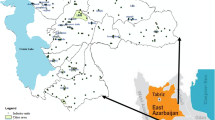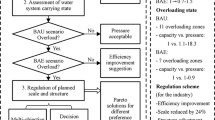Abstract
In this paper, the traditional problem of matching supplies to competing demands, referred to as water resources planning (WRP), is re-visited. With the pressure of continuing growth in the world's population, efficient development and management of available water resources are of greater importance than ever before. It is equally important in today's world that the environmental implications of any activity should be minimised. The aim of this research is to develop a methodology for including environmental considerations in the WRP process. This is achieved by weighting the costs of the various water resource options (both constructional and operating) to reflect their environmental impacts, prior to their inclusion in an economic planning model. The effect of such a weighting procedure is to encourage the selection of environmentally-friendly schemes at the expense of environmentally-damaging ones. The objective function of the combined methodology is to minimise the total environmentally-adjusted costs, discounted to a base year. A comprehensive planning tool named ENRES has been developed to carry out this task. The model allows the environmental impact assessment of all development options, either source components or transfer structures, to be undertaken prior to running the allocation procedure which is carried out by means of an optimisation technique. With the help of all the facilities provided, the model can be used in a planning exercise both with and without environmental considerations. In this way, it is possible to quantify the cost of environmental impacts in the planning process.
Similar content being viewed by others
References
Anglian Water Services, 1993, Economic Planning Model of Water Resources: RESPLAN User Guide, Anglian Water Services, Cambridge.
Bardossy, A., 1983, The Mathematics of Composite Programming, Working Paper No. 84–18. Department of Systems and Industrial Engineering, University of Arizona, Tucson.
Bardossy, A., Bogardi, I., and L. Duckstein, L., 1985, ‘Composite programming as an extension of compromise programming’, in P. Serafine (ed.), Mathematics of Multi-objective Optimisation, Springer-Verlag, New York, pp. 375–408.
Bleed, A. S., Gollehon, N. R., Razarvian, D., and Supalla, R. J., 1985, ‘Water development models for contemporary planning’, in H. C. Torno (ed.), Computer Applications in Water Resources, American Society of Civil Engineers, New York, pp. 326–335.
Brew, J., 1976, AWA Resource Planning Methodology, Internal Note, Anglian Water Authority, Cambridge.
Chaturvedi, M. C., 1985, ‘Large scale water resources systems planning: Approach and case study’, in H. C. Torno (ed.), Computer Applications in Water Resources, American Society of Civil Engineers, New York, pp. 1141–1150.
Dixon, J., 1986, ‘The role of economics in valuing environmental effects of development projects’, in J. Dixon (ed.), Economic Valuation Techniques for the Environment: A Case Study Workbook, John Hopkins University Press, Baltimore, pp. 3–10.
Environmental Protection Agency (EPA), 2003, 2003–2008 EPA Strategic Plan: Decision for the Future, United States Environmental Protection Agency, Washington DC.
Froukh, M. L., 2001, ‘Decision-Support system for domestic water demand forecasting and management’, Water Resour. Manag. 15(6), 363–382.
Goicoechea, A., Hansen, D. R., and Duckstein, L., 1982, Multi-objective Decision Analysis with Engineering and Business Applications, Wiley, New York.
Haimes, Y. Y., 1977, Hierarchical Analyses of Water Resources Systems: Modelling and Optimization of Large-scale Systems. McGraw-Hill, New York.
Harhammer, P. G., 1982, ‘Economic operation of energy systems under environmental impacts’, in S. Rinaldi (ed.), Environmental Systems Analysis and Management, North-Holland Publishing Company, The Netherlands.
Howe, C. W., 1976, ‘Economic models’, in A. K. Biswas (ed.), Systems Approach to Water Management, McGraw-Hill, New York.
Hufschmidt, M. M., James, D., Meister, A., Bower, B., and Dixon, J. 1983, Environment, Natural Systems, and Development: An Economic Valuation Guide. John Hopkins University Press, Baltimore.
Jamieson, D. G., 1985, ‘An integrated multi-functional approach to water resources management’, Hydrol. Sci. J., 31(4), 501–514.
Kitabatake, Y. and Takahashi, M., 1989, ‘Regional multi-objective planning of water supply and the disposal of residuals with due regard to interregional population distribution’, Environ. Plan. A. 12, 627–648.
Kitson, T., 1982, ‘The allocation of water for public supply within severn-trent water authority’, Optimal Allocation of Water Resources (Proceedings of Exeter Symposium), IAHS, Wallingford, pp. 193–202.
Lutz, E. and Munasinghe, M., 1993, ‘Integration of environmental concerns into economic analyses with special emphasis on valuation issues’, in E. Lutz (ed.), Toward Improved Accounting for the Environment, World Bank, Washington, DC, pp. 198–207.
Lutz, E. and Munasinghe, M., 1994, ‘Integration of environmental concerns into economic analyses of projects and policies in an operational context’, Ecol. Econ. 10, 37–46.
Miller, W. and Byers, D., 1973, ‘Development and display of multiple-objective project impacts’, Water Resour. Res. 9(1), 11–20.
Munda, G., Nijkamp, P., and Rieteld, P., 1995, ‘Multicriteria evaluation in management: Why and how?’, in Applying Multiple Criteria Aid for Decision to Environmental Management. Kluwer, Dordrecht, pp. 1–22.
Major, D. C. and Schwarz, H. E., 1992, Large-Scale Regional Water Resources Planning, Kluwer. Dordrecht.
National Rivers Authority (NRA), 1994, Water-Nature's precious Resource: An Environmentally Sustainable Water resources Development strategy for England and Wales, HMSO, London.
O'Neill, P. G., 1972, ‘A mathematical programming model for planning a regional water resources system’, J. Inst. Water Engin. 26(1), 47–61.
Page, C., 1984, Economic Planning Model of Water Resources, Anglian Water Authority, Internal Report, Cambridge.
Quazi, R., 2001, ‘Strategic water resources planning: A case study of Bangladesh’, Water Resour. Manag. 15, 165–186.
Raju, K. S., Duckstein, L., and Arondel, C., 2000, ‘Multicriterion analysis for sustainable water resources planning: A case study in Spain’, Water Resour. Manag. 14, 435–456.
Razarvan, D., Bleed, A. S., Supalla, R. J., and Gollehon, N. R., 1990, ‘Multistage screening process for river basin planning’, J. Water Resour. Plan. Manag. 116(3), 323–334.
Simonovic, S., 1989, ‘Application of water resources systems concept to the formulation of a water master plan’, Water Int. 14(1), 37–50.
Schramm, G., 1973, ‘Accounting for non-economic goals in benefit-cost analysis’, J. Environ. Manag. 1, 129–150.
Simonovic, S. P. and Bender, M., 1996, ‘Collaborative planning support system: An approach for determining evaluation criteria’, J. Hydrol. 177(3–4), 237–251.
Simonovic, S. P., Fahmy, H., and El-Shorbagy, A., 1997, ‘The use of object-oriented modelling for water resources planning in Egypt’, Water Resour. Manag. 11, 243–261
Srdjevic, B., Medeiros, Y. D. P., and Faria, A. S., 2004, ‘An objective multi-criteria evaluation of water management scenarios’, Water Resour. Manag. 18(1), 35–54.
Stansbury, J., Woldt, W., Bogardi, I., and Bleed, A., 1991, ‘Decision support system for water transfer evaluation’, Water Resour. Res. 27(4):443–451.
Stephenson, D., 1982, Optimum Allocation of Water Resources Subject to Quality Constraints, in Optimal Allocation of Water Resources (Proceedings of Exeter Symposium), IAHS, Wallingford, pp. 193–202.
UNESCO, 1987, Methodological Guidelines for the Integrated Environmental Evaluation of Water Resources Development, United Nations Environment Programme, Paris.
Water Resources Council, 1973, Principles and Standards for Planning Water and Related Land Resources, Federal Register, Vol. 38(174), Part III, pp. 24779–24869.
Water Resources Board, 1973, Water Resources in England and Wales, HMSO, London.
World Commission on Environment and Development, 1987, Our Common Future, Oxford University Press, Oxford.
Yurdusev, M. A. and D. G. Jamieson, 1977, ‘Development of a water resources planning model which includes environmental considerations’, in D. Rosbjerg, N. Boutayep, A. Gustard, Z. W. Kundzewicz and P. F. Rasmussen (eds.), Sustainability of Water Resources under Increasing Uncertainty. IAHS, Wallingford.
Yurdusev, M. A. and Arı, H., 1977, ‘An environmental impact assessment model for water resources screening’, in R. Denzer, D. A. Swayne and G. Schimak (eds.), Environmental Software Systems.-Vol. 2, Chapman & Hall, London.
Yurdusev, M. A., 1999, ‘Assessing environmental consequences of water projects based on a pseudo expert system approach’, J. Math. Comput. Appl. 4, 251–259.
Yurdusev, M. A., 2002, EnvironmentalIimpacts for Water Resources Planning. WIT Press, Southampton.
Yurdusev, M. A. and O'Connell, P. E., 2005, ‘Environmentally-sensitive water resources planning: II. A case study’, Water Resour. Manag. 19(4), 399–421.
Zeleny, M., 1973, ‘Compromise programming’, in J. L. Cochrane and M. Zeleny (eds.), Multiple Criteria Decision Making, University of South Carolina Press, Columbia, pp. 262–301.
Author information
Authors and Affiliations
Corresponding author
Rights and permissions
About this article
Cite this article
Yurdusev, M.A., O'connell, P.E. Environmentally-Sensitive Water Resources Planning. Water Resour Manage 19, 375–397 (2005). https://doi.org/10.1007/s11269-005-7999-x
Received:
Accepted:
Issue Date:
DOI: https://doi.org/10.1007/s11269-005-7999-x




